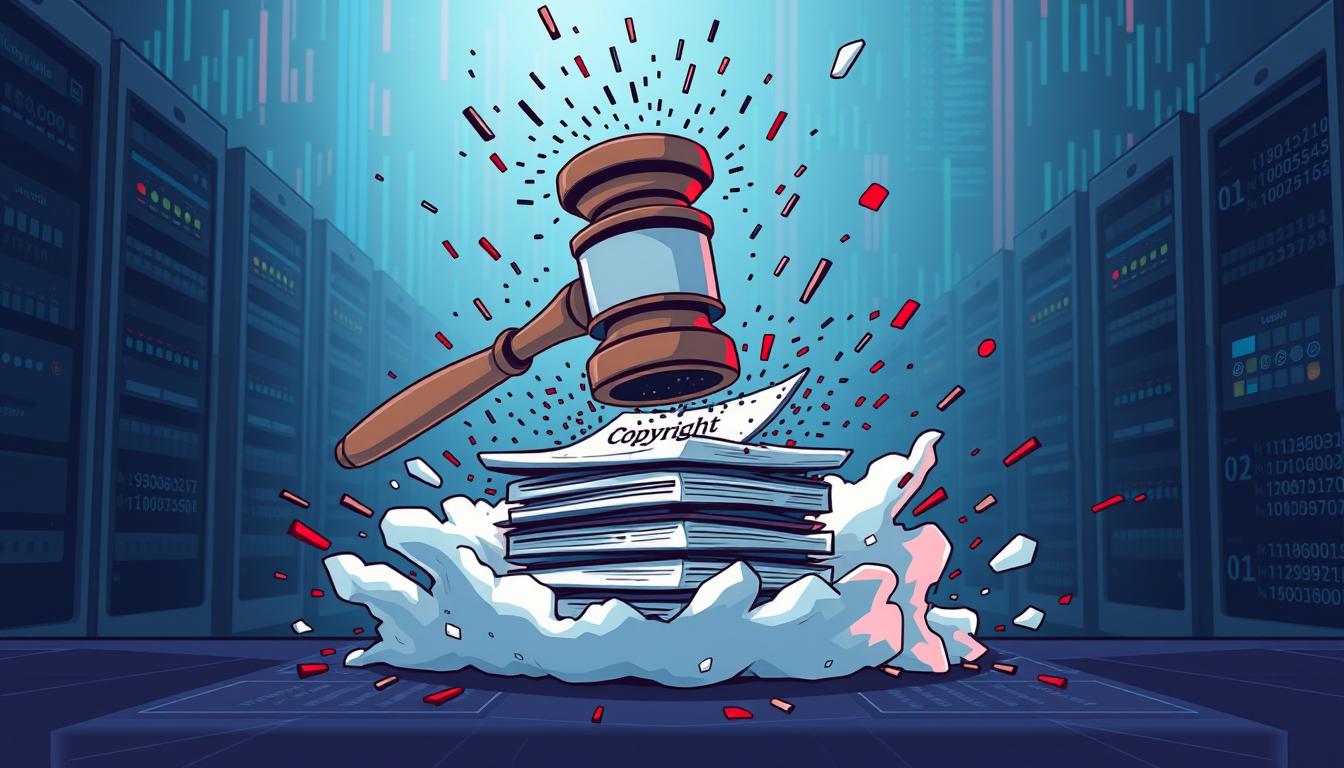Content can spread fast online. The Digital Millennium Copyright Act (DMCA) helps protect creators’ work. This article will cover the basics of DMCA takedowns. We’ll talk about the law’s purpose, the notice and takedown steps, and what makes a valid notice.
We’ll also discuss how to handle a takedown notice on your own content. Plus, we’ll look at tools and services for managing DMCA takedowns.
Key Takeaways
- The DMCA offers a way for copyright holders to ask for infringing content to be removed from websites and online platforms.
- DMCA takedown notices need to have certain details to be valid, like identifying the copyrighted work and the infringing material.
- Service providers might not remove material if the takedown notice doesn’t meet the legal standards. This could put them at risk.
- People who get a DMCA takedown notice can send a counter notice if they think the activity isn’t infringing.
- There are both professional services and DIY tools to help with the DMCA takedown process.
What is a DMCA Takedown Notice?
The DMCA takedown notice is a legal request to remove copyrighted material from online platforms. This is done without the owner’s permission. The Digital Millennium Copyright Act (DMCA) of 1998 governs this process.
The Digital Millennium Copyright Act (DMCA) and Its Purpose
The DMCA updated copyright laws to fight online piracy. It lets copyright holders ask websites to remove infringing content. This helps creators keep their work safe and in control.
The Notice and Takedown Process for Copyright Infringement
The DMCA notice and takedown process lets copyright owners tell service providers about unauthorized use. If a valid DMCA notice is received, the service provider must remove the infringing content. This keeps them safe from legal trouble.
| Key DMCA Takedown Statistics | Data Points |
|---|---|
| Websites with DMCA Takedown Forms | Approximately 1 in 3 websites provide a form for DMCA takedown requests |
| DMCA Compliance Requirements | The DMCA requires specific information in a takedown notice, such as a physical or electronic signature, identification of copyrighted material, and contact information |
| DMCA Safe Harbor Provisions | Service providers must remove or disable access to infringing works promptly to stay within the DMCA’s “safe harbor” provisions and avoid copyright infringement lawsuits |
The DMCA notice and takedown process is key for copyright holders. It helps them protect their work and fight online slander or defamation.
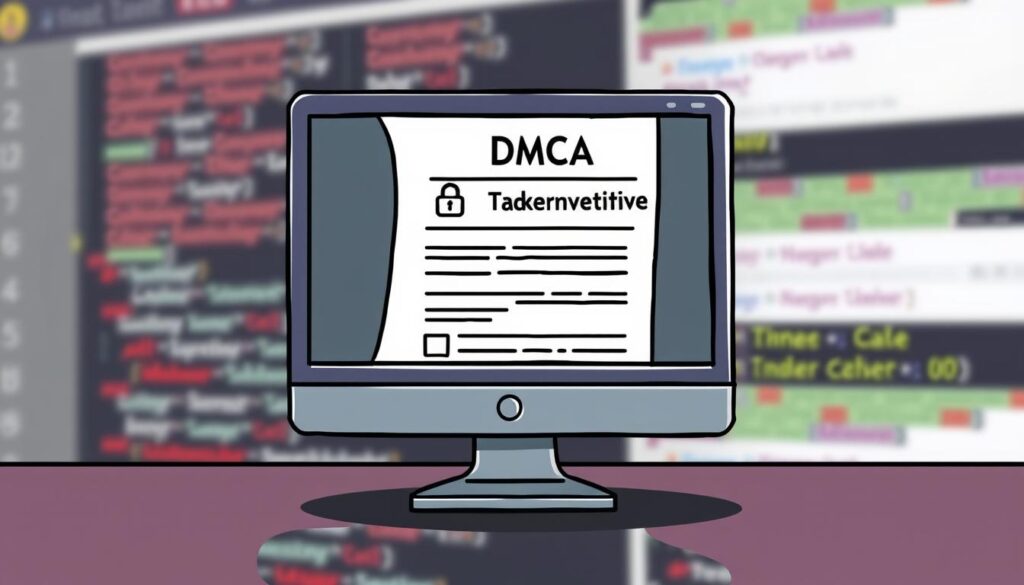
Requirements for a Valid DMCA Takedown Notice
When you’re fighting a wrongful DMCA takedown request or sending a DMCA notice for music copyright infringement, knowing the key elements is crucial. The Digital Millennium Copyright Act (DMCA) helps copyright owners protect their work online. But, service providers might not remove content if the notice lacks certain details.
Essential Elements of a Takedown Notice
- Signature: The notice needs the copyright owner’s or their agent’s signature. It can be physical or electronic, showing their role.
- Identification of Infringed Work: If many works are infringed, a representative list is okay. You don’t have to list each one.
- Infringing Activity Location: The notice must give enough info for the service provider to find the infringing material. This is usually a URL or an attachment.
- Contact Information: Your email address is key. You can also add an address or phone number.
- Good Faith Belief: The notice must say you genuinely believe the use of the materials is unauthorized.
- Accuracy of Statements: You must swear the notice is true. This includes saying you’re allowed to act for the copyright owner.
Consequences of Not Complying with DMCA Requirements
The Digital Millennium Copyright Act (DMCA) offers protection to website operators under certain conditions. If they follow the DMCA’s rules, they can avoid liability for copyright infringement. But, if a notice doesn’t meet the criteria, the service provider might not remove the content. Not following a valid DMCA notice can lead to losing legal protection and facing copyright infringement liability.
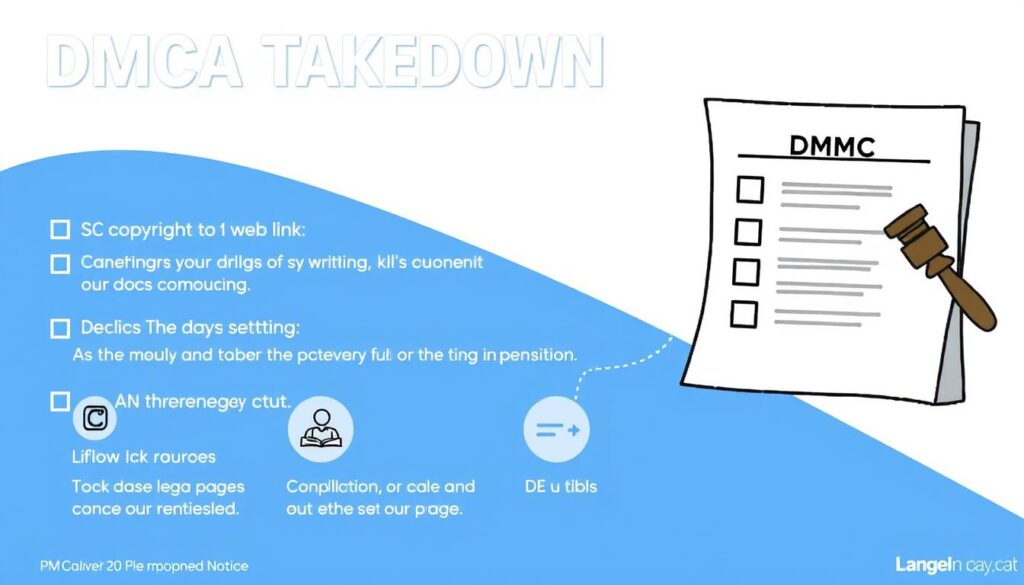
“Protecting your creative work online is essential, but the DMCA takedown process requires careful attention to detail. Ensure your notice includes all the necessary elements to avoid complications and secure a successful takedown.”
The DMCA Takedown Process Explained
The DMCA takedown process helps copyright holders remove infringing content from websites. They send a formal notice to the hosting service. The service must then remove the content or face legal issues.
Steps Involved in Filing a DMCA Takedown Request
To start a DMCA takedown, the copyright holder needs to give the service provider key details. This includes where the infringing material is, their contact info, and a statement of good faith. The service provider must act quickly, usually within 72 hours.
- Find the infringing content and its location on the website.
- Collect the needed info, like the copyright holder’s name, signature, and contact details.
- Send the DMCA takedown request to the service provider hosting the infringing content.
- The service provider will check the request. If it’s valid, they’ll remove the content or block access to it.
Responding to a Counter Notice and Legal Action
If someone who was removed disputes it, they can send a counter notice. The service provider must wait 10-14 days before putting the content back up. This gives the copyright holder time to sue the alleged infringer.
It’s key to know the DMCA takedown process applies to many digital content types. This includes text, images, videos, and music. Website owners should understand that a DMCA notice can be used for different types of online infringement, not just copyright issues.
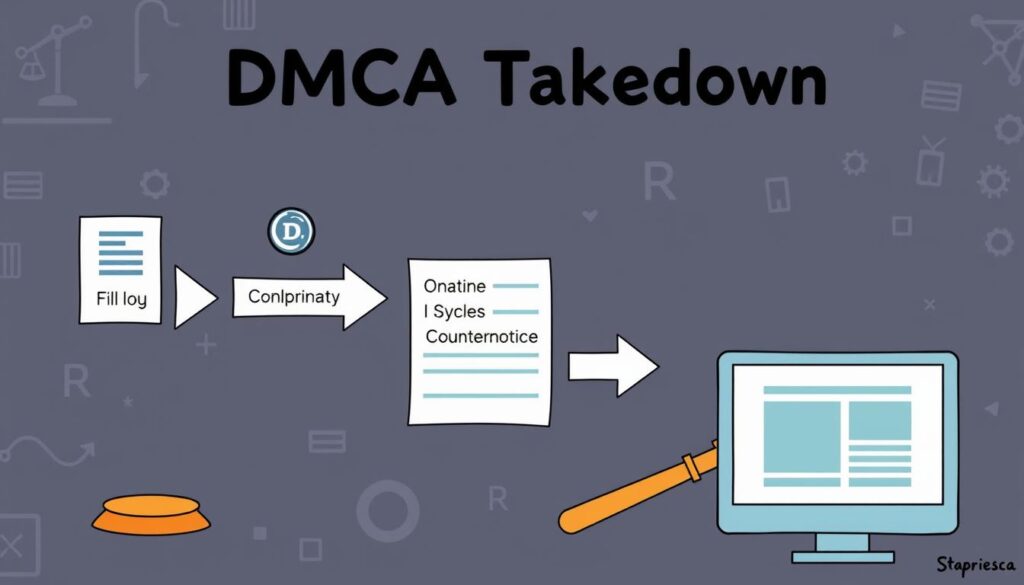
“Sending a DMCA notice to have content removed from search engines can prevent it from being visible in search results.”
Knowing the dmca takedown request process explained and the online dmca takedown request tools is vital. It helps both copyright holders and website owners protect their rights in the DMCA takedown world.
dmca takedown for Various Content Types
The DMCA takedown process helps copyright holders remove infringing content from the internet. This includes videos, images, and text. It’s useful for protecting your work on social media, e-commerce sites, or websites.
Protecting Intellectual Property with DMCA Requests
The Digital Millennium Copyright Act (DMCA) is key in today’s digital world. It lets copyright owners quickly remove unauthorized use of their content. This includes videos on YouTube or text without permission.
Studies show over 200,000 businesses trust a personalized DMCA policy generator. By sending a dmca takedown to Google or other providers, copyright holders can remove infringing material. This protects their creative works.
The DMCA requires online service providers to act on dmca requests to remove copyrighted content. This ensures the internet remains free while respecting copyright owners’ rights.
| Infringement Type | DMCA Takedown Process |
|---|---|
| Videos | Copyright holders can submit a dmca takedown for copyright infringement to the video-hosting platform, such as YouTube, to have the infringing video removed. |
| Images | A DMCA takedown notice can be sent to websites or social media platforms where copyrighted images are being used without permission. |
| Text | The DMCA process can be used to address the unauthorized republication of copyrighted text, such as articles, blog posts, or product descriptions. |
By using the DMCA’s takedown mechanisms, copyright owners can protect their intellectual property. They can keep control over their creative works online.
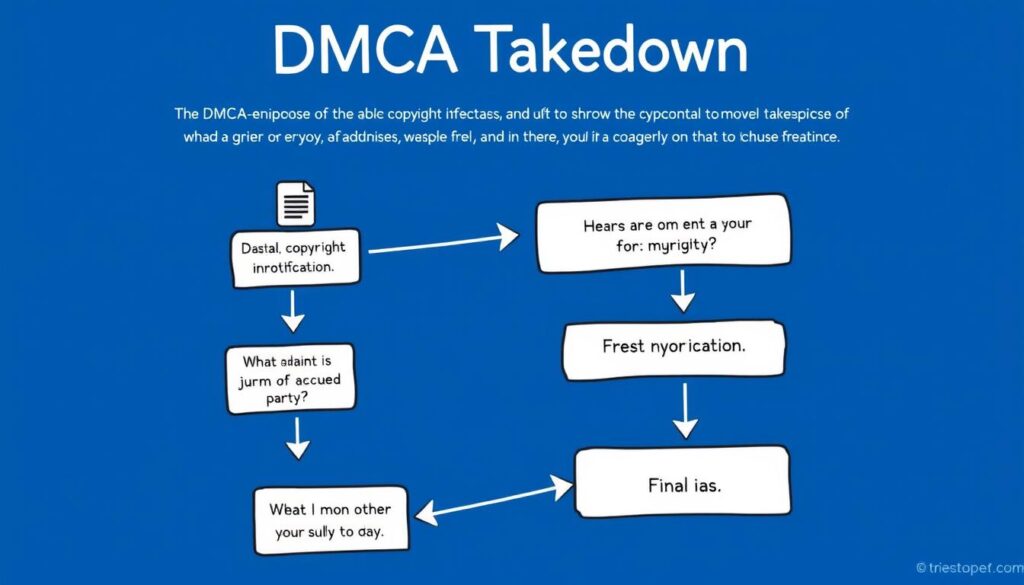
Handling a DMCA Takedown Request Against Your Content
Getting a Digital Millennium Copyright Act (DMCA) takedown notice can be scary. But, knowing your rights and what to do next is key. First, check if the claim against your content is right. If it wasn’t used with permission, take it down fast to avoid legal trouble.
Steps to Take When Receiving a DMCA Notice
- Read the takedown notice carefully to know what’s claimed against your content.
- Figure out if the use of the copyrighted material was okay, like fair use or a license.
- If it wasn’t okay, take down the content right away to follow the DMCA.
- If you think the notice is wrong, you can dispute the DMCA takedown and file a counter notice.
Disputing a DMCA Takedown and Filing a Counter Notice
If you think the DMCA takedown notice is not right, you can file a counter notice. This tells the service provider you disagree with the copyright claim. They must wait 10-14 days before putting your content back up unless the copyright holder sues.
To file a counter notice, you need to give details about the content, who you are, and why you think it was taken down by mistake. This can be tricky, so talking to a lawyer before you do it is a good idea.

It’s important to protect your intellectual property and handle DMCA takedown requests well. Knowing how to deal with these situations helps keep your online presence safe and your reputation intact.
Safe Harbor Provisions and Service Provider Responsibilities
The Digital Millennium Copyright Act (DMCA) has “safe harbor” rules. These rules protect online service providers (OSPs) from copyright infringement lawsuits. They must quickly remove infringing material after getting a valid DMCA takedown notice.
To get safe harbor protection, OSPs must follow some rules. They need to have a DMCA agent to receive takedown notices. They also have to have a policy for dealing with repeat infringers and support copyright owners’ technical measures.
- A copyright registration is not required before sending a takedown notice, but it is necessary for suing in court for U.S. works.
- If you are the copyright owner or authorized by the owner, you may send a takedown notice without needing to hire an attorney or professional service provider.
- Various information must be included in a takedown notice such as identification of the infringing material, the original work being infringed, contact information, and a statement of authorization.
- Takedown notices can be sent using a sample form provided by the U.S. Copyright Office or through site-specific webforms on some platforms.
- If there are multiple works infringed upon, a “representative list” of works can be included in a takedown notice instead of listing each work individually.
The DMCA safe harbor rules have sparked a lot of debate. Some say they are too broad. Others believe they strike a good balance between copyright holders and online service providers.
| Requirement | Details |
|---|---|
| Designation of DMCA Agent | OSPs must designate a DMCA agent to receive takedown notices and register the agent’s contact information with the U.S. Copyright Office. |
| Repeat Infringer Policy | OSPs must adopt and implement a policy to address repeat infringers, such as terminating the accounts of users who repeatedly infringe copyrights. |
| Accommodation of Technical Measures | OSPs must accommodate and not interfere with standard technical measures used by copyright owners to identify and protect their works. |
The DMCA safe harbor rules have sparked a lot of debate. Some say they are too broad. Others believe they strike a good balance between copyright holders and online service providers.
DMCA Takedown Services and Tools
In today’s digital world, protecting your intellectual property is crucial. Luckily, there are many services and tools to help. They range from professional services to DIY toolkits, meeting the needs of all.
Professional Managed Takedown Services
Reputation Return offers full-service DMCA takedown management. They handle everything from research to submitting the notice. It costs $199 per site, with a 100% money-back guarantee for a reliable solution.
Do-It-Yourself DMCA Takedown Toolkits
If you like to do things yourself, there are DIY DMCA takedown toolkits. They come with templates and guides for submitting your own requests. DMCA.com offers one for just $10 a month. It helps you remove content like images, text, and videos easily.
Choosing a professional service or a DIY toolkit, both can protect your online presence. They make dmca takedown services and tools essential for safeguarding your how to file a dmca takedown request.
“DMCA.com aims to make takedown processes accessible, affordable, and effective, providing tools for image, text, video, audio, and product protection.”
International Considerations for DMCA Takedowns
The DMCA is a US law for copyright. But, it can help remove infringing content worldwide. The success of DMCA notices depends on the host’s location and their choice to comply.
Copyright holders need to know about other countries’ copyright laws. DMCA Takedown Notices are requests by copyright owners to remove their content from websites, and the DMCA legally applies only in the USA. Still, international providers might honor these requests, especially if the copyright holder is a WIPO member.
- The DMCA Takedown process is used globally, as many countries accept the standard form and process.
- For a successful DMCA Takedown, you need the infringing URL(s), source URL(s), and a theft description.
- DMCA.com works with hosting companies worldwide, removing stolen content in 5 business days.
While the DMCA Takedown process can help remove infringing content worldwide, copyright holders should learn about international copyright laws. This ensures the best protection of their intellectual property.
“DMCA Takedown Notices are requests by copyright owners to remove their content from websites, and the DMCA legally applies only in the USA.”
Best Practices for Avoiding Copyright Infringement
As a content creator, it’s key to make sure you’re not using someone else’s work without permission. The best way to avoid DMCA takedowns is to get the right permissions before using any third-party content. Also, creating 100% original content and respecting others’ IP rights can help you avoid copyright problems.
Obtaining Proper Permissions and Licenses
Before using copyrighted material, like images, text, or video, get the necessary permissions or licenses. This might mean contacting the copyright holder, buying a license, or using public domain content. Always give credit when using licensed content to avoid infringement claims.
Creating Original Content and Respecting Intellectual Property Rights
Spending time and effort on creating original content is the best way to avoid copyright infringement. This means writing your own text, designing your visuals, and making your own audio or video. Always check that you have the right to use third-party resources, like stock images or music, in your content.
By following these best practices, you can create and publish content safely, without worrying about DMCA takedowns or copyright infringement.
“Copyright is a form of protection provided by the laws of the United States for original works of authorship, including literary, dramatic, musical, artistic, and certain other intellectual works.” – U.S. Copyright Office
- Obtain proper permissions and licenses before using third-party content.
- Focus on creating 100% original content to respect intellectual property rights.
- Properly credit sources when using licensed or public domain materials.
- Verify the right to use third-party resources, such as stock images and music.
By following these guidelines, you can confidently create and publish content without the risk of DMCA takedowns or legal issues related to copyright infringement.
Conclusion
The Digital Millennium Copyright Act (DMCA) is key for creators and owners to guard their work online. Knowing how to use the DMCA helps protect against copyright issues. This knowledge is vital for keeping your digital content safe.
This article has covered the basics of DMCA takedown notices and how to file them. It’s useful whether you’re sending a notice or responding to one. The steps and details can guide you in making the right choices.
The DMCA world is always changing, with new issues for everyone. Keeping up with updates, getting help when needed, and avoiding infringement are crucial. These steps help manage DMCA takedowns effectively.
In short, the DMCA is a strong tool for defending digital rights. Understanding it lets creators and businesses handle online issues with confidence. This way, they can keep their content and reputation safe.
As the digital world keeps changing, managing DMCA takedowns will become even more important. By staying informed and proactive, you can protect your rights and keep your online space secure.
Reputation Return Helps with DMCA Takedowns
If you’re dealing with unauthorized use of your intellectual property online, Reputation Return is here to assist. We are a top provider of DMCA takedown services. Our team of experts will handle everything for you.
We’ll research the infringing content, submit the formal notice, and follow up until it’s removed. You can rest easy knowing we’ve got this.
Protecting your rights is our main goal. We help content creators, business owners, and individuals safeguard their online presence. Our DMCA takedown services give you peace of mind. This way, you can focus on your work while we take care of the legal and technical parts.
If you need help with a DMCA takedown, contact Reputation Return. Our team is ready to support you. We’ll help you protect your rights and keep your online presence strong. Reach out to us today to learn more about our services and how we can assist you.

